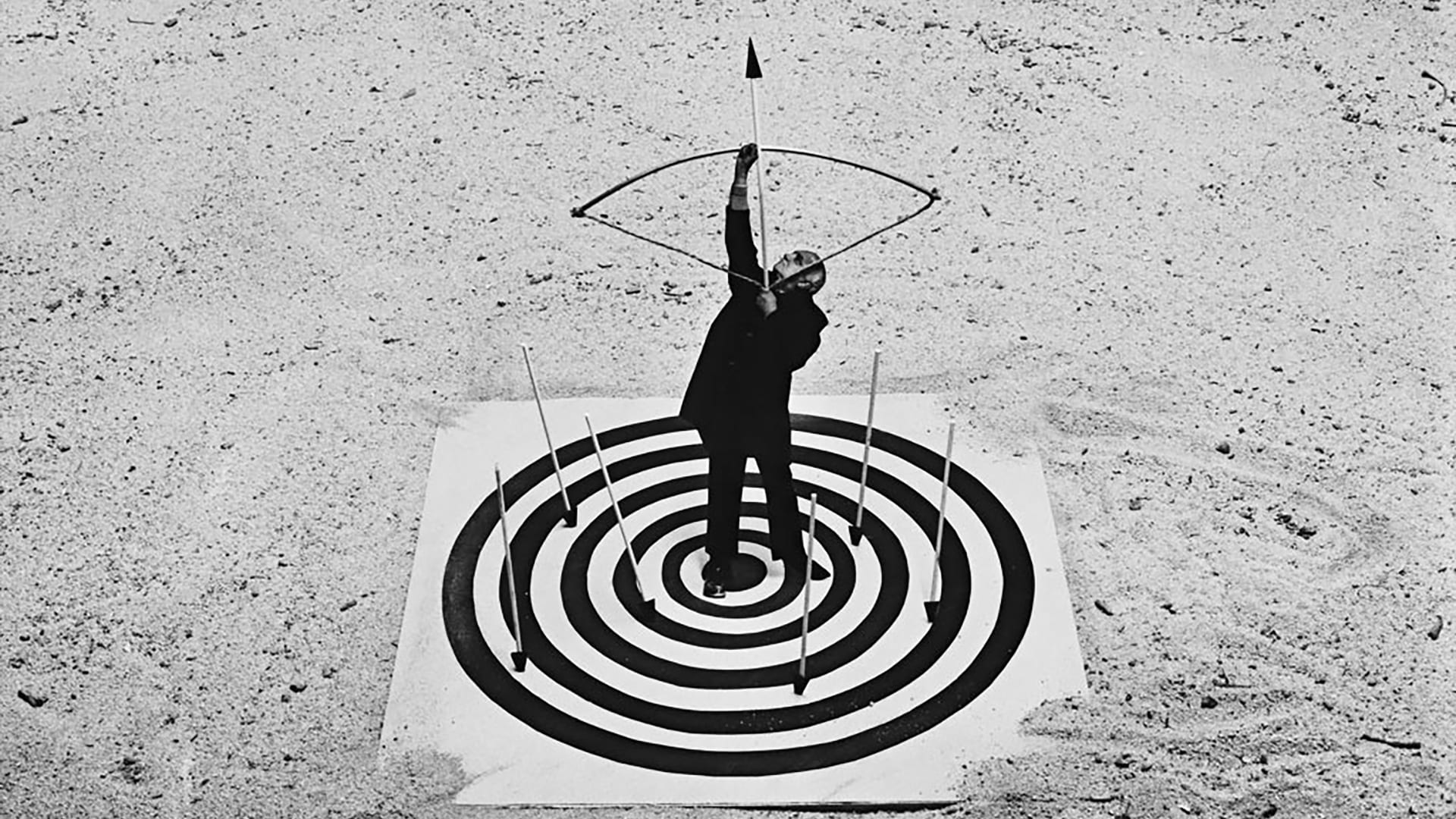
Le bon diagnostic, 1999, courtesy Galerie Camera Obscura
He came to photography late in life, at sixty-five. He did a photography internship just to occupy his time in retirement, but then a true artist was born. Today, we are bidding farewell to Gilbert Garcin who died at the age of ninety, leaving behind endearing, funny, and witty photographs.
There is no mistaking his style. Every image features the adventures of a miniature hero in a make-believe black-and-white world. He is most often alone, sometimes with a female companion; she invariably wears a dress and a pair of heels; he can be seen in a dark buttoned-up coat. On occasion he covers his bald head with a sun hat. This little explorer of dreamworlds is called “Monsieur G.”—a scaled down figure of Gilbert Garcin, sometimes accompanied by his wife.
The black-and-white photomontages were crafted in his modest studio in La Ciotat. The whole world fits on a small table covered with sand, illuminated by a spotlight, and furnished with odds and ends. Every image is titled. Gilbert Garcin thus takes us by the hand and ushers us into the world of his imagination.
His work evokes Magritte’s paintings, Hitchcock’s cameo appearances, and the cinema of Jacques Tati. When we look at S’y perdre [Getting Lost] it is hard not to think of Monsieur Hulot’s Holiday: four Monsieurs G. in sunhats cast shadows across a cardboard maze. Gilbert Garcin’s photography is one of a kind and timeless. It was exhibited in every major gallery and won hearts the world over.

Le choix évident, 2003, courtesy Galerie Camera Obscura
“His was a really special case”
“His work is admirable. I love his irony, his at times caustic sense of humor, his poetry,” remarked the printer and photographer Guillaume Geneste, founder of the Paris-based lab La Chambre Noire, who made numerous prints for Gilbert Garcin. “He had collaborated for a long time with the printer Bernard Caramante. I began working with him five years ago; his son, our go-between, showed up one day with a large orange photo album,” recalled Geneste.
Over two decades Gilbert Garcin created more than three hundred works: allegories of the passing time and human condition combining dark humor, melancholy, and dreams. They offer a bemused look at his own life: that of a man born in 1929 in La Ciotat and won over to photography after keeping a lighting store in Marseille for forty years.
As Guillaume Geneste hunches over new prints of Garcin’s work, he is in contact only with the photographer’s son. It is very rare in his profession to never have met the artist. This singular relationship can be explained by the simplicity of the print: “His photographs are not difficult to develop, there isn’t a great variation in lighting. He uses studio lighting. I have followed the earlier prints, and Gilbert Garcin never refused me a photo. He never wanted much in terms of retouching and liked the fact that you can see the homemade aspect of the photos,” noted Geneste.
This highly original body of work is quite different from images usually processed by Guillaume Geneste. “His was a really special case. I could hardly speak of printing colors, as in Lartigue’s photos which I’ve been working with for twenty-five years. But this is not to sound simplistic. It was his way of seeing things,” explained the printer, regretting he never got to meet the artist in person.

L’ambition raisonnable, courtesy Galerie Camera Obscura
A timeless body of work
A simple montage of inexhaustible richness: every little scene conveys a philosophical message, always delivered with a touch of self-mockery and mischief, to be teased out by the viewer. Some images refer to Greek myths in order to comment on the modern world. For instance, in Icare contracarré [Icarus Foiled] Gilbert Garcin is tied to a weight that holds him down even as he is trying to take flight with the help of a rubber balloon.
In Le dessous des choses [The Hidden Side of Things] Garcin’s Liliputian figure lifts the hem of an immense white sheet that stretches out of sight. It’s as if the diminutive character were tugging at the horizon. This universal, timeless body of photographs recounts the adventures of “Monsieur G.” with his daily struggles, joys, absurdity, and beauty.
“When I heard of his death, I opened one of his albums. Some images are pure poetry,” said Guillaume Geneste, going on to describe L’arbre qui voulait voir la mer [The Tree That Wanted to See the Sea], in which a sapling, walking on two legs, contemplates the waves washing up on the shore. Gilbert Garcin was always surprised by the success of his photos: he saw his life come to an end at the water’s edge, a fishing rod in his hand. “His photography will live for centuries to come,” assured him Guillaume Geneste.

S’y perdre, 1993, courtesy Galerie Camera Obscura

Le dessous des choses, courtesy Galerie Camera Obscura

Upward, courtesy Galerie Camera Obscura

L’envol d’Icare (d’après Léonard de Vinci), courtesy Galerie Camera Obscura

Le coeur de la cible, 1998, courtesy Galerie Camera Obscura
By Michaël Naulin


